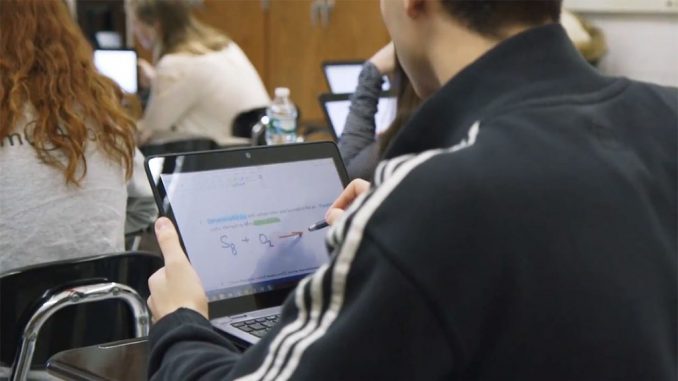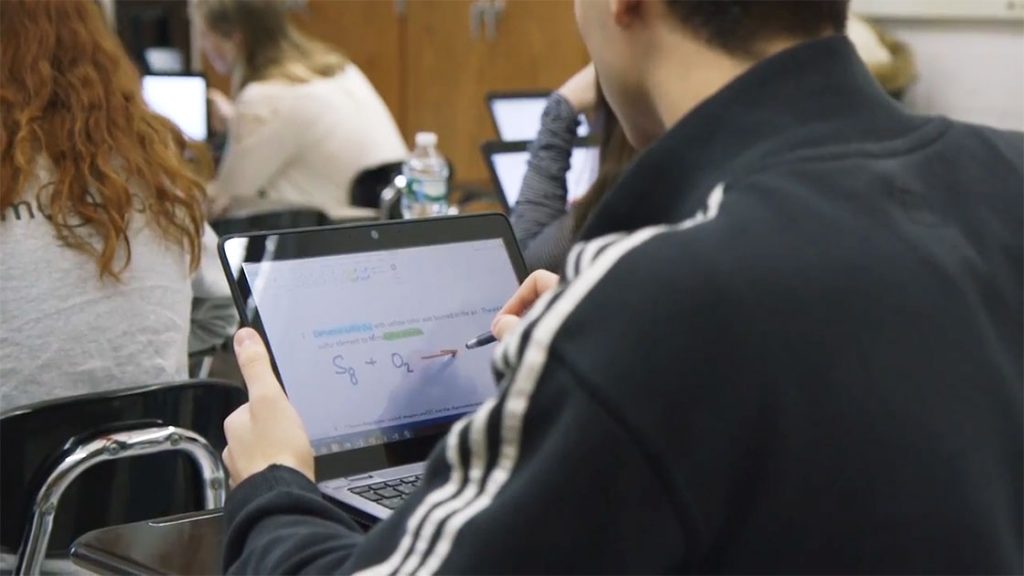
River Dell Regional School District gives students connected classrooms and digital ink

Students and teachers decide what technology the district should adopt. Their choice: Windows 10 and Microsoft Education.
River Dell Regional School District in New Jersey has a middle school and high school comprised of more than 1,700 students and 131 educators. When it came time to renew their computer equipment the district they asked the teachers and students what they wanted.

OneNote’s collaboration space encourages students to work together on the same document at the same time, whether it’s a shared writing project or gathering data for a science lab report.
River Dell Regional School District has equipped every student and teacher with a Windows 10 touch- and pen-enabled laptop with Microsoft Office 365 and OneNote. This combination enables teachers to work more efficiently, facilitates personalized learning opportunities for students and fosters a collaborative learning culture.
“We had a teacher and student committee that researched and selected the devices with us,” explains Marianthe Williams, director of technology for the district. “As a 1:1 school district for over 10 years, it was essential to have teacher and student involvement in the selection process.”
The committee developed a rubric to determine what criteria were important in and out of the classroom, and what functionality would enable them to do their best work while staying within the budget. “The group wanted 24/7 access to all their files with wireless, portable devices and digital inking capabilities,” said Williams.

While teachers roam the room, they can write on the Surface tablet and have the display projected on a screen in the front of the class.
The top priority for students was to find a device that offered a variety of modern capabilities, including keyboard, touch and pen. Williams noted, “For certain subjects such as math, science and music, students really need the ability to take notes by hand so they can make diagrams and sketches.” Research shows that digital inking results in long-term retention and better learning outcomes. Students produce 56 percent more non-linguistic content [diagrams, symbols, numbers] when using digital inking rather than a keyboard, which leads to an improvement in performance of 9 to 38 percent.* Teachers are more productive with digital ink as well since they are able to offer individualized feedback which improves personalized student learning. Another study showed that 68 percent of educators improve the quality of their communications with students by using a touch-based device with a stylus.**
As the district began testing different types of devices, including laptops, Chromebooks, and tablets, the choice became clear. “Hands-down, the committee selected the Surface Pro 3 because it was easy to use, intuitive, and lightweight,” Williams explained. All teachers and staff were issued the Surface Pro 3. High school students received the HP EliteBook 820, while the middle school students received the HP ProBook 11 Education Edition. “We were pleasantly surprised to find the HP devices offered the touchscreen features our students craved at a price point the district could afford.”

With the Surface tablets, teachers are freed from their stationary post in front of the class.
Over the summer, the district made a smooth transition to Windows 10 on all devices. Not only did the students keep the productivity tools in Office 365 to which they were so accustomed, but they also benefited from digital inking features they craved. The upgrade to Windows 10 provided a user experience that students and teachers were already familiar with and opened a new world of touch and pen features.
Williams said, “We’re all-in with Surface, HP, Microsoft Office 365 and OneNote. It’s exciting to see how our teachers and students have taken OneNote Class Notebook to be their digital curriculum. The technology helps us to extend learning beyond the instructional period. Our students are finding new ways to collaborate and developing skills that will serve them well throughout their lives and careers.”
With the Surface Pro 3 tablets, teachers are freed from their stationary post in front of the class. While teachers roam the room, they can write on the Surface tablet and have the display projected on a screen in the front of the class. “You have a very strong pulse of the class when you can walk around,” explains U.S. History teacher, Dawn Rivas. “I can write on the tablet, and it goes up immediately on the projector and kids will see that.” Using the stylus allows students and teachers to incorporate notes and comments directly into the lesson in a way that does not interrupt the flow of the classroom. Teachers report that their lessons are considerably enhanced, with students who are more engaged and are able to draw better conclusions.
The most exciting instructional catalyst was Microsoft OneNote Class Notebook, which has taken collaborative learning to a new level. “The game changer is OneNote Class Notebook. Our teachers have really embraced it,” said Williams.

River Dell Regional School District in New Jersey has had a 1:1 device program in place for 10 years. But the technology program really took off after every teacher was given a Microsoft Surface Pro 3 over the 2015-2016 school year.
With OneNote Class Notebook, students can ask for help, and teachers can give their support—directly in the student’s personal notebook. OneNote’s collaboration space encourages students to work together on the same document at the same time, whether it’s a shared writing project or gathering data for a science lab report. OneNote automatically saves notebooks so that students and teachers can view them from any device, online or offline. Williams says, “Teachers tell us that they are more efficient as they can check student progress at any time and that the students have higher homework completion rates.”
To learn more about how Microsoft is empowering every student to achieve more, visit Microsoft in Education.
*Computer Interfaces and their Impact on Learning, Sharon Oviatt.
**Digital Ink in the Classroom, IDC InfoBrief sponsored by Microsoft, June 2015.
Source: River Dell Regional School District gives students connected classrooms and digital ink






Leave a Reply